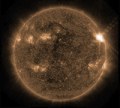 The sun is just a spinning ball of hot gas, 1.4 million kilometres across. The Deceived Wisdom about spinning balls if of course that they should bulge at their equator because of centrifugal force, the fast moving matter at the equator being flung out more than that at the North or South poles, like kids on the edge of a roundabout rather than those clinging to the middle.
The sun is just a spinning ball of hot gas, 1.4 million kilometres across. The Deceived Wisdom about spinning balls if of course that they should bulge at their equator because of centrifugal force, the fast moving matter at the equator being flung out more than that at the North or South poles, like kids on the edge of a roundabout rather than those clinging to the middle.
Indeed, astronomers had always expected our nearest star to bulge slightly at its equator. The gas giant planet Jupiter (which shone so brightly alongside Venus and the crescent moon in the morning sky the other is very oblate because of this phenomenon. Jupiter rotates on its axis once every 10 hours (its day is less than half as long as an Earth day). This makes it almost 7% wider across its equator than the distance from pole to pole, explains The Guardian. It’s very oblate. The Earth too is flattened by its spin making it an approximate oblate spheroid rather than a perfect sphere. Measure its diameter through the poles and it is about 12,715 km, but the equatorial diameter is 12,756 km). One would expect the Sun to have a significant difference too, given that it is so much bigger, although the Sun takes about five Earth weeks to spin on its axis once.
However, a team at the University of Hawaii has now pinned down the first precise measurements of the Sun’s equatorial bulge as part of a 50-year ongoing effort. Surprisingly, results show that the Sun does not have as big an equatorial bulge as one might expect. The difference between equatorial and polar diameter is more than 41 km. The difference for the Sun is a fraction of that at a mere 10 kilometres. In percentage terms the difference on Earth is almost a third of one percent. For the Sun, it’s a tiny 0.0007%.
Research team leader Jeffrey Kuhn and colleagues suggest that this makes the Sun the most near-perfect sphere. According to the Guardian if one were to scale the Sun to the size of a beachball the difference would be less than that of the proverbial human hair. “Only an artificial sphere of silicon that was created as a standard for weights is known to be more perfectly spherical,” the report says.
The explanation for this near perfection might lie in the fact that although the Sun’s total rotation is about 34 Earth days, the outer surface layers may not be rotating at the same rate. “The solar oblateness is substantially lower than theoretical expectations by an amount that could be accounted for by a slower differential rotation in the outer few percent of the Sun,” the team reports in the journal Science.
![]() Kuhn, J.R., Bush, R., Emilio, M. & Scholl, I.F. The Precise Solar Shape and Its Variability, Science, DOI: 10.1126/science.1223231
Kuhn, J.R., Bush, R., Emilio, M. & Scholl, I.F. The Precise Solar Shape and Its Variability, Science, DOI: 10.1126/science.1223231
But, why are stars and planets “spherical” in the first place? According to a SciAm Q&A: “Planets are round because their gravitational field acts as though it originates from the centre of the body and pulls everything toward it. Over long periods of time the stuff from which the planet is made succumbs to the gravitational pull from its centre of gravity so that any protuberances are smoothed out. The process is known as “isostatic adjustment.” The process requires that the mass of the astronomical object be large enough that gravity can do this, which is why asteroids tend to stay lumpy their smaller gravitational field is not big enough to pull them into a spherical shape.